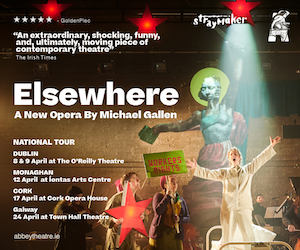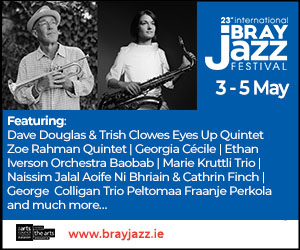
Thomas Adès and the Britten Sinfonia (Photo: Chris Christodoulou)
Composer Discovers Orchestra!
It’s probably fair to say that Gerald Barry’s style doesn’t quite fit into the standard concerto format. The traditional emphasis on the soloist that defines the genre still holds sway today and most contemporary composers continue to spend a lot of time – often in collaboration with the prospective soloist – devising novel ways of best exploiting the sonic capacities of the instrument. Barry, on the other hand, has never really been one for fiddling around with extended techniques or flashy idiomatic writing. His music has a hard, abstract design and part of the excitement of a Barry premiere comes from the friction that results when this design is imposed on the ensemble regardless of whether the writing is idiomatic for the instruments or not. Thus brass players are given extended streams of semiquavers, singers are forced to negotiate lines that violinists would struggle with, and the orchestra is treated like a gigantic harmonium.
Perhaps wary of the expectations of many soloists to write specifically for their instrument, Barry has steered clear of writing concerti for most of his career. The last few years are the exception and have seen him embrace the genre with enthusiasm, first with a Piano Concerto in 2012 and then with last year’s Organ Concerto, both strange beasts that oscillate wildly between the sublime and the shambolic. This new viola concerto written for the British violist Lawrence Power – which was receiving its second performance by the Britten Sinfonia under conductor Thomas Adès at London’s Barbican – may however be the wackiest of the lot.
Crotchets and quavers
It began with a forceful blast from the trumpets and tuba in crotchets answered by the trombones and French horns playing an arpeggio in quavers. This was followed briefly by some slapstick percussion (wind machine, lion’s roar, thunder sheet, triangle) before the soloist made his entrance sans orchestra with a spectacularly underwhelming melodic line consisting entirely of quavers. The brass and percussion was repeated and off we set again with another line for the soloist, marginally more sophisticated this time (there was more double-stopping) but resolutely in quavers. For a third time, in came the brass/percussion followed by more of the same for the soloist.
After this, the quaver melodies began to be passed around between each instrumental family of the orchestra forming an unbroken line mostly in unison. Fragments of banal exercises (do, mi, re, fa, mi, so, etc.) began to appear, shared between the soloist and strings. At one point an octave leap was passed from trombone, to cello, to viola, to oboe, to bassoon, to clarinet, to French horn, to tuba and back to the soloist in an amusing exercise in orchestral democracy. From the midway point, the piece became much louder involving the whole orchestra playing in unison and dialoguing back and forth with the soloist. The only reprieve from the dreaded quavers came at the very end where a brief coda containing a simple major key melody (in crotchets) was played by the solo viola over a primitive accompaniment whereupon the piece ended on a poignant note with Power whistling this melody (still in crotchets) at a slower tempo.
Stroppy student
This description may make the concerto sound slightly farcical, but, in fact, it was quite the opposite. It possessed a playful, indeed almost childlike sense of naivety that felt almost as if it had been written by a composer from another planet who had just discovered something called an orchestra and was trying it out for the first time. While the complete absence of instrumental blending or any kind of orchestration technique would likely drive many a composition professor to despair, Barry somehow managed to get away with it.
In addition, there was also a comic aspect that Power carried off wonderfully. With his hair all ruffled and maintaining a frown throughout, he resembled a stroppy student who suffers from an aversion to practicing and who had been coerced into giving the performance at the behest of a reproachful teacher. His playing had a calculated roughness to it with several passages deliberately out of tune. Thus the piece seemed to revel in the ecstasy of the mundane and the mediocre, an obvious contradiction that may partially explain why it came across as so successful.
Barry’s concerto was sandwiched between Beethoven’s seventh and eighth Symphonies, both of which received electric performances under Adès who knew exactly when to choose his moments. For instance, there was nothing particularly striking about the exposition of the first movement of the seventh – it was merely very good. But when the same material returned in the recapitulation it did so with an attention to detail that beautifully drew out the differences between it and the material we heard earlier. Repeats were selectively adhered to and the performance was also a classic example of long-range planning. While the two middle movements were exceptional there was still plenty of gas left in the tank for the finale that was taken at a faster tempo than usual leaving the audience in the Barbican gasping for breath. The Britten Sinfonia seemed to relish the challenge and delivered everything Adès asked of them.
As well as a gifted composer, Adès must rank as one of the best conductors around at the moment. While his podium technique may have more in common with a premiership football manager than Herbert von Karajan, his performances are consistently at a level that demonstrates a deep knowledge of music’s architecture whether it be a Beethoven symphony or the more DIY assemblages of Gerald Barry.
Listen back to the concert on BBC Radio 3 here. The Barry concerto begins at 42’. There is a short interview with the composer at 38’30”.
Published on 30 May 2019
Adrian Smith is Lecturer in Musicology at TU Dublin Conservatoire.

















